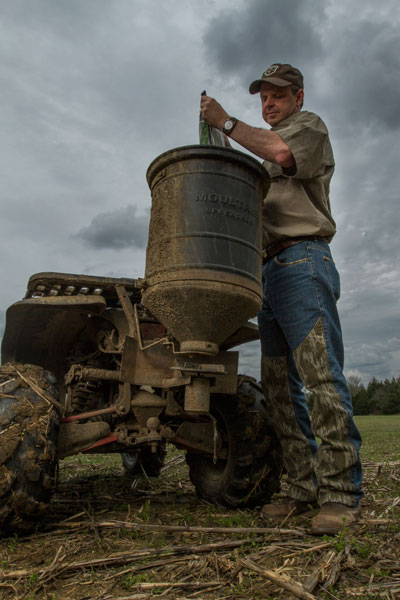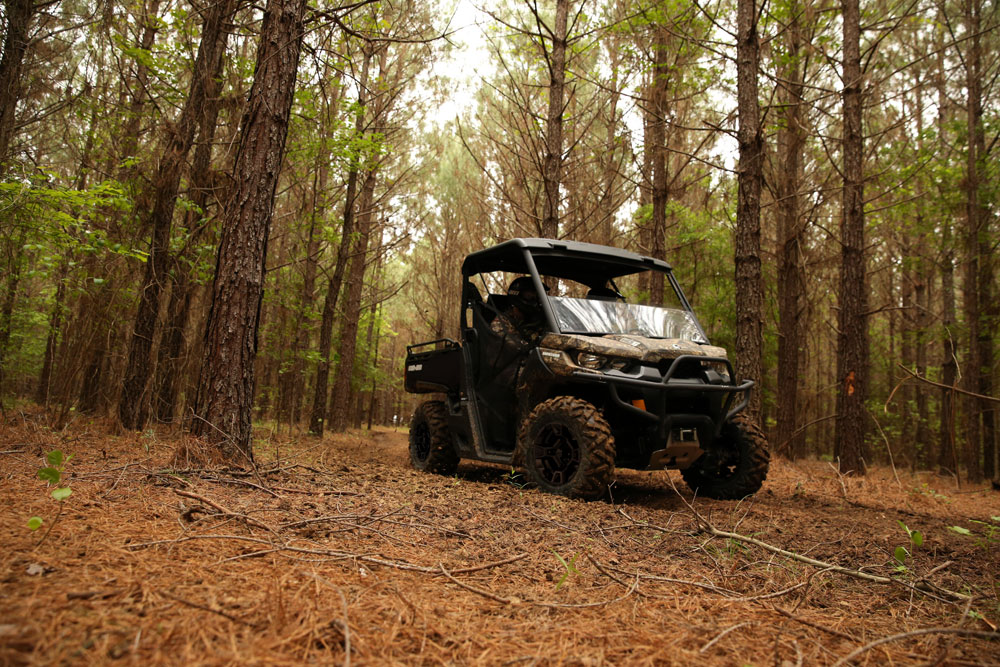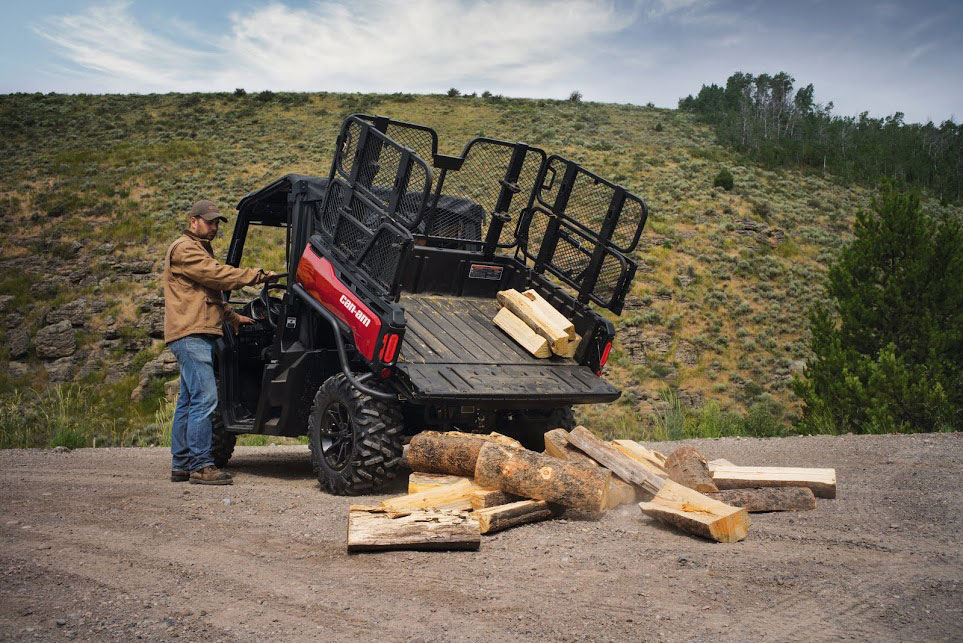Bob Humphrey | Originally published in GameKeepers: Farming for Wildlife Magazine. To subscribe, click here.

attachments, should be kept in good working order.
Change doesn’t come easy to any of us, but it does come, and sometimes for the better. Hunter’s Safety education is a prime example. At one time it was optional and thought of as a good idea, but not particularly necessary. As more states made it mandatory we saw a trend: a significant decline in the rate of hunting accidents. Now virtually all states require it for new hunters, and the forests and fields have never been safer, at least for hunters.
Widespread acceptance of ATV safety education just might, and probably should be the next big trend in outdoor recreation. It’s mandatory in some states for youths, but few if any require it for adults. And while mandatory education may not be necessary, being more safety conscious while riding and working on your ATV is most certainly a good idea for all of us.
ATV Safety Starts with You
ATV safety begins and ends with the operator. In between, there’s much you can do to ensure you return safely, whether riding for work or pleasure. And the process begins before you climb aboard.
Many, I dare say, most folks probably hop on their ATV, turn the key and head for the hills with little thought for what they wear. That could be a huge mistake. ATV manufacturers and the ATV Safety Institute strongly recommend wearing proper safety equipment at all times while riding. That includes a helmet, eye protection, gloves and boots, a long-sleeved shirt and full-length pants. All except for the helmet are also a wise choice when you step off your ATV, whether it is for hunting, wood cutting, food plot work, etc.
If you’re going to ride, wear a helmet. Vanity and comfort are about the only reasons not to, and make for a pretty poor excuse when you consider that head trauma is among the most common type of injury experienced by ATV riders. Whether you wear a standard model or full-face version is largely a matter of personal preference. Visors and face shields are optional, but worth considering, more on the latter in a bit.
Gloves protect your hands from brush and other objects while riding. They also keep your hands warm in cooler temperatures and provide for a better grip on handlebars or steering wheels. They’re also nice to have once you dismount for hunting or field work as they’ll protect you from myriad potential cuts, scrapes, burns and other injuries and provide a more secure grip on gun or tools.
Above-the-ankle boots protect your feet from an array of potential injuries while riding, especially if you’re on a four wheeler versus a side-by-side. And you’d be hard pressed to think of a form of hunting where high boots are not a better option. They provide support in rough terrain, warmth, and protection from the elements and things like ticks, chiggers and poisonous snakes.
Long-sleeved shirts and long pants are advisable for many of the aforementioned reasons. They’ll protect you from brush and thorns, biting insects and exposure to the elements, including too much sun. If it’s hot, wear lighter, moisture-wicking fabric, but cover your arms and legs.
Last, but most certainly not least, is eye protection. If your helmet doesn’t have a face shield, glasses or goggles will protect your eyes from branches, insects or flying objects while riding. Once you step off, you still need to protect your eyes, especially when running power equipment. Switch from goggles to safety glasses if need be, but keep your eyes protected. Crashing through brush on an upland bird hunt could result in a stick in the eye. Shooting into a strong wind could result in ejected shells or powder residue blowing back in your face. Even a random gust could blow dirt or other objects into your eye. Running a chainsaw or brush cutter offers all kinds of potential hazards and even on a tractor, it’s possible you could blow a hydraulic line spraying hot oil into your eyes if they’re not protected.

Maintaining Your Equipment
You should always keep your ATVs in good working order. At best, a breakdown could mean a long walk home or an unexpected overnight in the woods. At worst, malfunctioning parts could result in an accident and potentially serious injury. Your owner’s manual should provide instructions on how to perform routine maintenance. If you don’t have one, you can usually find a copy online at the manufacturer’s website. Always follow the manufacturer’s specifications and instructions. And by all means, if you can’t do it yourself, take your machine to a qualified mechanic.
Safety On the Trail
Now that you’ve got your equipment in order you’re ready to ride. There’s much you can do to ensure safe travels. First, stay off the road. ATVs, which include both four wheelers and side-by-sides, are classified as OHRVs (Off-Highway Recreational Vehicles). They’re designed for off-road travel and not recommended for paved roads, except to cross when done safely and permitted by law. If you must travel on the road for short distances, go slowly, stay to the side and follow all traffic rules.
When operating an ATV, you should always stay sober. Avoid drugs or alcohol, including prescription drugs. Take seriously the warnings on prescription medication advising you not to operate machinery because anything that slows your reflexes or dulls your senses represents a potential safety hazard. If you’re feeling sick and need medication, take a day off or get someone else to pull your ATV implements around while you “supervise.” Save the liquid libations for after the job is done. Who actually rides on or in your ATV is also an important safety concern. Most four wheelers are designed for one person and you should never carry a passenger on a single-rider ATV. Someone riding on the front or rear racks could fall off or get extremities caught in moving parts. It also affects the balance and handling of the machine. Some ATVs are specifically designed for two people. They should have a passenger seat behind the driver with some type of containment and possibly hand grips. In that case, don’t carry more than one passenger. Make sure you can handle the machine. Small-framed adults and especially kids may find it difficult to handle larger ATVs. Remember, these are tools, not toys. If you do let kids ride, make sure they’re on age-appropriate machines and are under adult supervision. Always ride within your means. The biggest issue here is speed. How fast you go can vary with terrain and other conditions. Travel slowly enough that you have full control of your machine at all times. That takes care of general operation, now for some specifics.
When making a turn, shift your body weight forward and to the outside on a slow turn (the opposite of what you would do when on a snowmobile); lean your upper body toward the inside while keeping your weight on the outer footrest on a faster turn. Operating on sloped terrain presents its own set of challenges. It’s better if you can avoid side-hilling—driving across slopes—especially in slippery or bumpy terrain. It’s often, but not always, better to go straight up or down. Shift your body weight forward when ascending and toward the rear when descending. In either case, keep both feet firmly on the footrests and use lower gears. Machines with engine braking are helpful on descents. When it’s time to stop, release the throttle, shift to a lower gear and apply the brakes evenly and gently.

ATV Safety and Education
The more knowledgeable you are about ATV operation the safer you’ll be when riding. If you have not already done so, consider taking an ATV safety course, especially if you have kids. Most states offer them free of charge as part of their outdoor education program. There are also plenty of resources available on the internet, including a free online E-Course at www.ATVsafety.org.































